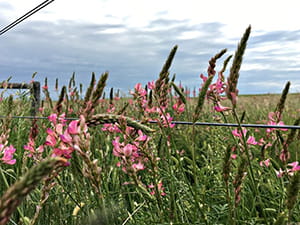By Keana Boere, AAg, Agri-Environmental Specialist, Outlook
March 2024
Seeding a successful perennial forage stand takes planning and a little luck. Forage seed is an investment—planning and following best practices for establishment improve your chances of getting a good catch and a productive stand.

growing in a perennial forage crop stand.
Spring is generally the recommended time to seed perennial forages as this is the best opportunity for good soil moisture conditions.
What other practices can you do to improve your chance of success in seeding a productive forage stand?
- Species selection is an important first step. You want to select species that will grow in your area and be productive for your specific end-use goals. Some species are better suited for use in a hay stand while others perform best under grazing.
- Use high-quality seed to improve germination and reduce the risk of weed seed contamination. Certified #1 or Common #1 seed is recommended.
- Most forage seeds are very small and should not be seeded deeper than 12 mm (1/2 inch).
- A firm seedbed is best for forage seeds to have good seed to soil contact. Clean, unworked stubble makes a good seedbed.
- Seeding rates will vary depending on your area. Ideal seeding rates are based on the targeted pure live seeds per square foot (metre) and the average available precipitation for your area.
- Starting with a clean, weed-free field is important to give forage seedlings a strong start. Control weeds before seeding, especially stubborn perennial weeds.
- Select the appropriate inoculant if seeding any legume species. Each legume or group of legumes requires a unique species of rhizobium to form nodules and fix nitrogen for the plant.
- Forages require nitrogen, phosphorus, potassium, sulphur and micronutrients to remain productive. Soil testing is the best way to assess soil nutrient levels and results can be used to decide on fertilizer options. Be aware of the safe rates for seed-placed fertilizer with forage crops.
- Patience. Forages are slow to establish compared to many annual crops, and often require over a year to be fully established.
If you are looking for more details on forage seeding and species selection, the Saskatchewan Forage Crop Production Guide is a great resource.
The Resilient Agricultural Landscapes Program provides funding to producers through several Beneficial Management Practices (BMPs). These BMPs aim to improve the resiliency of agricultural lands by improving water quality, soil health, and biodiversity. The Seeding Tame Forage BMP and Seeding Native Forage BMP are both available to assist producers in seeding perennial forage species. For more information, call the Agriculture Knowledge Centre at 1-866-457-2377 or contact your local agri-environmental specialist.
